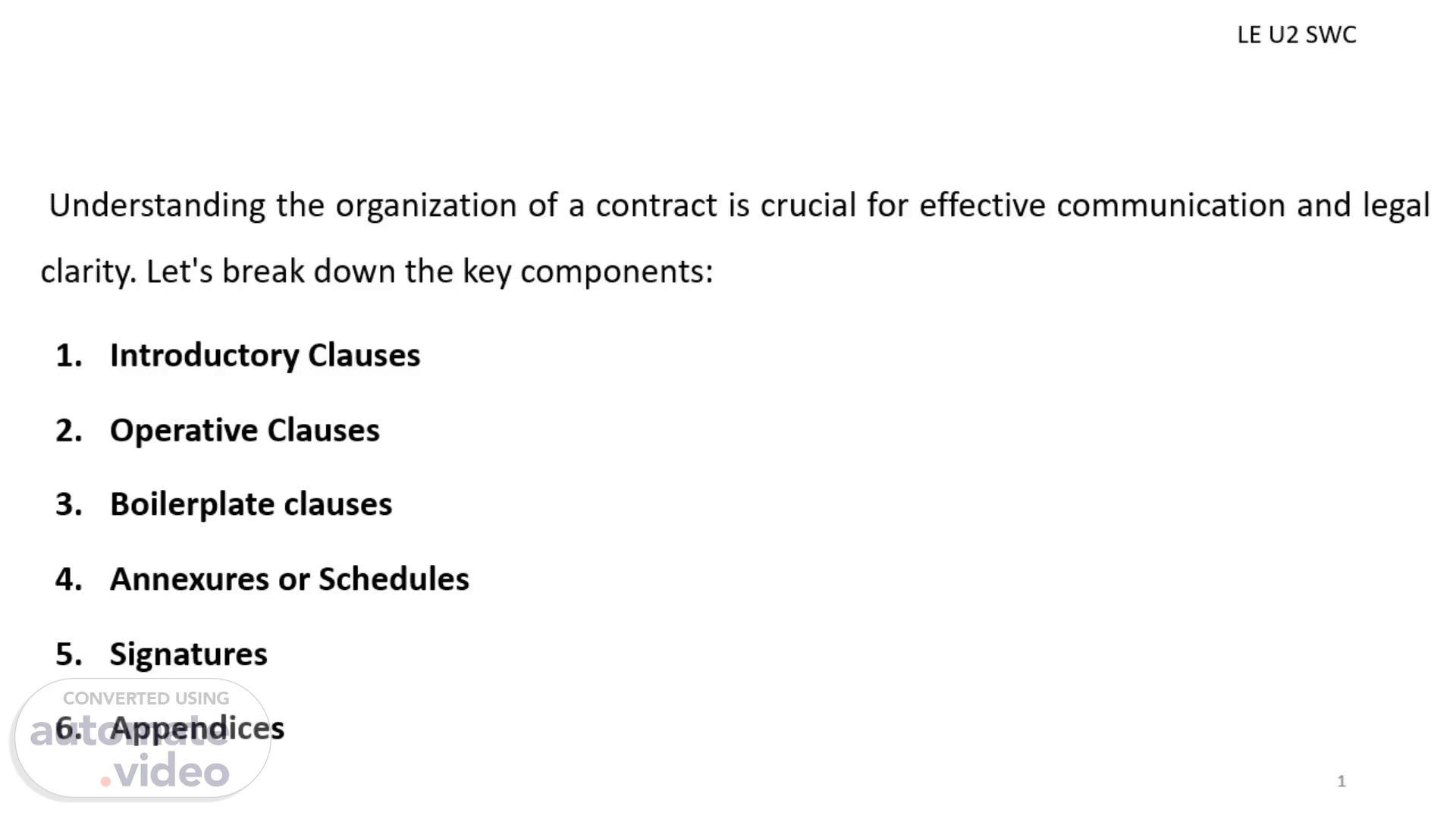
PowerPoint Presentation
Scene 1 (0s)
[Audio] In the realm of contracts, a well-organized structure is the foundation for clear communication and legal precision. The components outlined here guide us through the contractual journey. From the preamble, setting the tone, to the appendices providing additional details, each element plays a vital role in shaping a comprehensive and effective contract. Join us as we delve into the intricacies of the contract structure, unraveling the purpose and significance of each segment.
Scene 2 (31s)
LE U2 SWC. INTRODUCTORY CLAUSES. 2. The introductory clauses set the foundation for the contract, establishing the context, parties involved, and the contract's purpose. This section includes: Title: A clear and descriptive title aids easy identification and reference. Date and Parties: The contract's execution date determines its validity and identifies the parties involved. Recitals or Preamble offers background and context, the recitals outline the reasons behind the agreement and the parties' shared intentions. Definitions refer to the key terms defined to ensure clarity and prevent misunderstandings..
Scene 3 (56s)
LE U2 SWC. OPERATIVE CLAUSES. 3. The operative clauses form the core of the contract, specifying the rights, obligations, and responsibilities of the parties. This section includes: Statement of Agreement: Explicitly stating that the parties agree to the terms and conditions laid out in the contract. Main Terms and Conditions: This section details specific rights, duties, payment terms, and other essential provisions relevant to the transaction. Conditions Precedent and Subsequent: Certain conditions must be met before the contract becomes effective (conditions precedent) or before specific obligations are triggered (conditions subsequent). Representations and Warranties: Parties may make statements about present facts (representations) or promises about future performance (warranties). Indemnification and Liability: Outlines how breaches and damages will be handled and the extent of liability..
Scene 4 (1m 30s)
LE U2 SWC. BOILERPLATE CLAUSES. 4. Boilerplate clauses are standard, non-negotiable provisions that set the legal framework and govern the relationship between parties. This section includes: Governing Law and Jurisdiction: Specifies the applicable laws and jurisdiction for dispute resolution. Entire Agreement: Asserts that the written contract represents the complete understanding between the parties, superseding prior agreements. Amendment and Waiver: Outlines procedures for making changes or amendments and clarifies that waiver doesn't permanently relinquish rights. Severability: Ensures that if one part of the contract is deemed invalid, the rest remains in effect. Confidentiality and Non-Disclosure: Safeguards sensitive information from disclosure to third parties..
Scene 5 (1m 59s)
LE U2 SWC. ANNEXURES OR SCHEDULES. 5. Annexures or Schedules are attachments that provide additional details and supporting information. This section includes: Specifications: Detailed technical specifications or requirements related to the products or services being exchanged. Pricing and Payment Terms: A breakdown of the pricing structure, payment schedules, and associated conditions. Timelines and Milestones: Outlines project stages and milestones. Forms and Appendices: Additional forms or information required. Legal and Regulatory Documents: Relevant legal or regulatory documents attached to the contract..